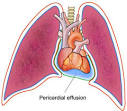 Pericardial effusion occurs when too much fluid builds up around the heart. The heart is surrounded by a double-layered, sac-like structure called the pericardium. The space between the layers normally contains a very small amount of fluid.
Pericardial effusion occurs when too much fluid builds up around the heart. The heart is surrounded by a double-layered, sac-like structure called the pericardium. The space between the layers normally contains a very small amount of fluid.
But if the pericardium is diseased or injured, the resulting inflammation can lead to pericardial effusion. Fluid can also build up around the heart without inflammation. Sometimes, pericardial effusion can be caused by the accumulation of blood after a surgical procedure or injury.
When the amount of fluid exceeds the pericardium’s “full” level, pericardial effusion puts pressure on the heart, causing poor heart function. If left untreated, pericardial effusion can cause heart failure or even death.
Symptoms
You can have significant pericardial effusion and experience no signs or symptoms, particularly if the fluid has increased slowly.
If pericardial effusion symptoms do occur, they may include:
Shortness of breath or difficulty breathing (dyspnea)
Discomfort when breathing while lying down (orthopnea)
Chest pain, usually behind the breastbone or on the left side of the chest that often feels worse when you breathe and feels better when you are sitting up, rather than lying down
Cough
Low-grade fever
Rapid heart rate
Causes
Inflammation of the pericardium (pericarditis) is a response to disease, injury or an inflammatory disorder that affects the pericardium. Pericardial effusion is often a sign of this inflammatory response.
Pericardial effusion may also occur when the flow of pericardial fluids is blocked or when blood accumulates within the pericardium. It’s not clear how some diseases contribute to pericardial effusion, and sometimes the cause can’t be determined.
Complication
The pericardium can hold only a limited amount of excess fluid without causing problems. The inner layer of the pericardium is made of a single layer of cells that sticks to the heart. The outer layer is thicker and only somewhat elastic. When too much liquid collects, the pericardium expands inward, toward the heart.
When pericardial effusion puts pressure on the heart, the pumping chambers of the heart fail to fill completely, and one or more chambers may partially collapse. This condition, called tamponade (tam-pon-AYD), causes poor blood circulation and an inadequate supply of oxygen to the body. Tamponade is a life-threatening condition if left untreated.
Treatment and drugs
Treatment for pericardial effusion will depend on how much fluid has accumulated, what is causing the effusion, and whether pericardial effusion has caused or is likely to cause decreased heart function due to pressure on the heart (cardiac tamponade). Treating the underlying cause of pericardial effusion often corrects the problem.
Medications that reduce inflammation
If you don’t have tamponade or there’s no immediate threat of tamponade, your doctor may prescribe one of the following to treat inflammation of the pericardium that may be contributing to pericardial effusion:
Aspirin
Nonsteroidal anti-inflammatory drugs (NSAIDs), such as indomethacin (Indocin) or ibuprofen (Advil, Motrin IB, others)
Colchicine (Colcrys)
If you don’t respond to medications or you have recurring pericardial effusion after a successful treatment, your doctor may prescribe a corticosteroid, such as prednisone.




